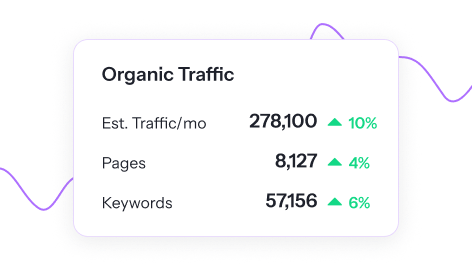Once upon a time, it was believed that search engines like Google and Bing couldn’t index PDF files. In 2011, Google revealed that it’s been indexing PDF files since 2001.
Today, Google even has a tag in the search engine results pages (SERPs) indicating that the result is a PDF file. While the search engine giant has hundreds of millions of PDF files indexed, it’s still best practice to use this format only when necessary.
Whether you’re looking for SEO tips for PDFs or looking for the answer to the question “Are PDFs good for SEO?” you’re in the right place. This article will answer your burning questions so you can start optimizing your PDFs for SEO.
When should you use a PDF over an HTML page?
While your PDF (or portable document format) files can appear in SERPs and even in featured snippets, these files have some disadvantages over HTML pages.
For one, PDFs are not mobile-friendly. Their consistent layout across all devices makes browsing on a small screen challenging. Because PDFs typically don’t get as many updates as web pages, search engines don’t crawl them as often.
In some instances, though, the use of PDFs makes more sense. A good rule of thumb is to publish new content in PDF when:
- Your audience will need to print it out following the exact specifications
- Your audience will need to refer to it when they’re offline
Here are some content examples that work well as PDFs:
- Ebooks
- Product manuals and guides
- Product specifications documents
- White papers
8 SEO tips for PDFs
Optimizing PDFs for SEO calls for a unique set of tactics. Let your PDF files conquer SERPs by employing these best practices:
- Write useful content
- Make your PDF easy to view on mobile
- Add links to and from web pages on your site
- Optimize your PDF’s file size for the web
- Use your target keyword in the PDF’s filename
- Optimize your PDF’s title and description tag
- Consider offering an HTML version of your PDF
- Track your PDF file downloads
Let’s dive into each one:
1. Create useful content
This is possibly the cardinal rule of SEO, regardless of file format. Create helpful content for your target audience, and it will rank in Google when searchers look for it.
Pro tip
Ensure your PDF file is text-based so that Google’s crawlers can index your file. If you can copy and paste the text from your PDF file, it’s text-based! If your PDF is image-based, Google uses optical character recognition technology to extract the text.
2. Make your PDF easy to view on mobile
While PDFs are not mobile-friendly in general, there are ways to make viewing them on mobile easier to improve the experience for your readers. After all, more than half of website traffic comes from mobile devices!
Here are some tips:
- If possible, choose a portrait orientation instead of a landscape one to minimize horizontal scrolling.
- Align your text to the left to make it easy for your readers to scroll through your pages and find information.
- Divide your content into sections with subheads to make the document easy to skim.
- Keep paragraphs short—about three to four sentences each—to make the PDF easier to read.
- Use bullet points when applicable and when outlining key takeaways.
- Use only the necessary images that support your text in your PDF file because Google can’t index images in PDF files.
3. Add links to and from web pages on your site
According to Google’s Search Central Blog, links in PDF files are like links in HTML pages. That is, they can pass link juice. So, if you want your PDF to rank in SERPs, link to it in relevant pages.
Doing so increases its indexing signals and helps your audience find helpful content that addresses their next search intent.
Lead your PDF file readers to other relevant content by providing links to relevant pages that address their next search intent. Include the actual URL of the HTML page in addition to the anchored text so that offline users reading the printed version can visit them later.
Pro tip
If your PDF’s layout allows, consider adding a QR code or a shortened link for easy access to a relevant page.
4. Optimize your PDF’s file size for the web
Compress your PDF file so that its size is optimized for the web. Doing so provides a pleasant experience for your users.
Mind the number of fonts you use. Use PDF-supported ones to reduce file size:
- Courier
- Helvetica
- Symbol
- Times
- Zapf Dingbats
Need to use your brand’s font? You can embed fonts. Just ensure you compress the PDF file, as embedded fonts can increase your PDF file’s size!
5. Use your target keywords in the PDF’s filename
Consider your PDF’s filename like a URL. Make it SEO-friendly by incorporating your target keyword into the filename.
For example, if your PDF file is a product specifications file, use product-name-specs.pdf as its filename to immediately communicate the file’s topic with readers and search engines.
Pro tip
Keep your filename short. Use lowercase characters and hyphens or underscores in between words to avoid conflict with Internet servers.
6. Optimize your PDF’s title and description tags
Think of your PDF’s properties as their metadata. You can edit the properties of your PDF file using Adobe Acrobat by going to File > Properties.
Treat the title field as your page’s title tag and the description field as the description tag. Aim to use unique titles and descriptions for each PDF file so they don’t cannibalize one another in rankings!
7. Consider offering an HTML version of your PDF
If you want to offer an HTML version of your PDF, you can do so. Ensure that your PDF is unindexable and allow your readers to download the PDF version.
You can get creative and offer the PDF as gated content that will be emailed to their inbox!
8. Track your PDF file downloads
How many users landed on your website through organic search and downloaded your PDF? Tracking the number of downloads your PDFs get lets you measure their popularity.
As a result, you can further optimize them for SEO. You can also identify the content types that your readers are interested in.
Ready to start optimizing PDFs for SEO?
While the short answer to “Are PDFs good for SEO?” isn’t yes, it doesn’t mean you should refrain from using them. Publishing new content in PDF format has its benefits and serves your target audience’s needs.
Ensure you employ SEO best practices for PDFs to increase their chances of ranking in search engines, helping your audience find relevant information from your site! SEO.com is a user-friendly SEO tool that makes it easy to track your SEO performance, research keywords, and make data-driven optimizations. Try it for free today to take your SEO strategy to the next level!
Discover Your SEO Potential
Pinpoint opportunities on your website faster and increase your visibility online with SEO.com!

Find Keyword Opportunities Faster
Keyword research doesn’t have to be complicated. Make it easier with SEO.com!
Writers

Related Resources
- 5+ SEO Tips for Landing Pages to Boost Your Rank and Revenue
- 6 SEO Best Practices for Product Pages to Conquer SERPS
- 7 SEO Tips for Videos to Help You Get More Views and Rank in SERPs
- 7 Types of Content to Inspire Your Marketing Strategy
- 9 SEO Best Practices for Category Pages to Rank in SERPs
- Content Pruning: Boosting SEO by Cleaning Up Your Website’s Content
- Does AI Content Work for SEO? What to Know About AI Content
- Does Grammar Matter in Content Marketing?
- Evergreen Content vs. Viral Content — Which is Better for SEO?
- Why is Content Important for SEO? (And How to Get Started)


